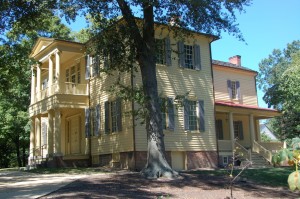Thursday evening, some of the neighborhood email lists lit up with discussion of the planned Interpretive Center at Mordecai Historic Park. The center is going through the planning stages and the proposed location has been selected by staff, with the Mordecai Historic Park (MHP) board and the Raleigh Historic Districts Commission both offering their approvals. Three public meetings have addressed the center and public feedback up until now has been overwhelmingly positive, with the project receiving a standing ovation at its public hearing in the Mordecai neighborhood in November.
When first presented with this plan at the Mordecai board meeting, I was concerned that the board was not given time to properly vet this plan. I needed time to study it and get my questions addressed. I recognize the historical importance of the park and wanted to make sure we did this right. It remains the only time I voted in the minority as a Mordecai boardmember.
But then I learned more about the project. At the public hearing, I realized that the large buildable area marked on the map was simply that: buildable area. It did not represent the building’s footprint. And feedback from the neighbors showed support for the project.
Then a wonderful thing happened at the board’s last meeting in March. We had a good, in-depth discussion. We discussed every other possible location in detail, with its pros and cons. It became obvious that this was the best location. Also, the scope of the building had been scaled back dramatically, with only 2900 sf being discussed for the Wake Forest Road side, rather than the 5,000 the master plan calls for (or the 6,500 buildable sf that was originally shown). When I saw that new the plans didn’t dramatically reduce the park’s open space, it seemed like the perfect solution. With no pressure whatsoever, the board voted unanimously to approve the plan, with me offering the motion to approve and the other, formerly-dissenting boardmember seconding my motion.
Fast forward to this past Thursday. When I learned of the debate raging on the mailing lists, I felt I needed to get the neighborhood and the project experts together to dispel any rumors and get the facts straight from the source. On less than 24 hours notice, I confirmed that site manager Troy Burton and Clearscapes architects Fred Bellelin and Steve Schuster would be present. Project manager Shawsheen Baker confirmed her attendance three hours before the meeting and Cyrus Stacy, MHP board chair, attended too. A number of neighbors were present when the meeting convened at noon Sunday around the park’s shaded picnic tables.
For the next hour the project planners outlined the project, discussed the rejected alternatives, and took questions from the neighbors. While some neighbors might not have agreed with all the answers they were given, the project planners didn’t dodge the tough questions. They were frank and open with the facts and answered everything they were asked. Then the crowd walked over to the proposed site of the center and studied it closely.
I couldn’t help but notice the non-stop noise from Wake Forest Road during the meeting, with mopeds and motorcycles rumbling by every few minutes. It drowned out the discussion at points. I also took note of how unattractive the Salvation Army building is from the Mordecai grounds. Putting that together, it seemed little wonder why most wedding parties at Mordecai choose to set up shop on the back side of the property.
During the discussion, I explained how much I enjoy the interpretive center over at Wake County’s Oak View Park. The interpretive center at Oak View provides kids a few hands-on experiences that Mordecai House and most other historic sites do not allow. The photographs and displays really bring to life the history of the place, arguably better than any docent could. I think the interpretive center could really tell the story of the Mordecais in a way that the house alone cannot.
As a Mordecai park volunteer for the past three years, I am acutely aware of the need for additional space. Many times I have arrived at the house right as the Park was preparing for one of its many big events. I’d have to step around the costumes or artifacts laid out in the hallways of the house because there was no other place to put them. In addition, there are historical artifacts tucked in nearly every corner of the house. As a result, many items in the collection are deteriorating at a rapid pace. This is no way to treat historical artifacts and historical buildings. More storage and work space are long, long overdue. This center will undoubtedly prolong the collection and improve the park experience.
The other thing to keep in mind is that the Interpretive Center has been part of the master plan since the Park was designed in 1989. It’s not something that’s suddenly being added to the park: it’s always been a part of the Park. That master plan is now 21 years old (legal drinking age, in fact) and in those 21 years the need to tell the Mordecai story hasn’t diminished. In fact, it’s more important than ever.
I care about the neighborhood and I care about the Park. Where I differ with some is that my concern for the park doesn’t end with the lawn. Mordecai Historic Park plays an increasingly important role in the community and in the city itself. It is the reason Raleigh is here. It has a wonderful story to tell, and the Mordecai Interpretive Center is the best way to tell that story.
